-
 The Elegance of Cotton Sarees is Evergreen: 10 Different Types Of Cotton Saree You Must Have in Your Wardrobe (2020)
The Elegance of Cotton Sarees is Evergreen: 10 Different Types Of Cotton Saree You Must Have in Your Wardrobe (2020)
-
 Long Kurtis Can Be Statement Pieces If You Know How to Style Them Properly! 10 Amazing Long Kurti Designs and How to Style Them in Different Ways (2020)
Long Kurtis Can Be Statement Pieces If You Know How to Style Them Properly! 10 Amazing Long Kurti Designs and How to Style Them in Different Ways (2020)
-
 Rock the Latest Lehenga Trends: 10 Stylish Saree Lehenga Recommendations for a Scintillating Look (2020)
Rock the Latest Lehenga Trends: 10 Stylish Saree Lehenga Recommendations for a Scintillating Look (2020)
The Mystery Behind Variation in Saree Lengths
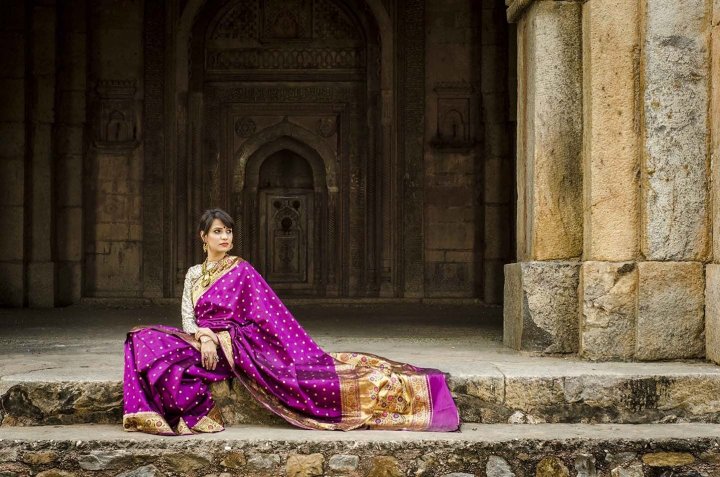
It Depends Upon the Way it is Draped
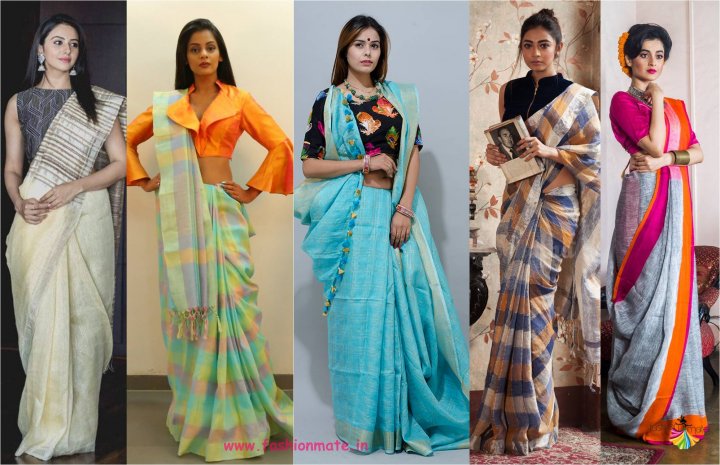
Not only the entire saree length but even the saree pallu length depends on the way it is draped. In India, every different region, or state has its own saree draping style. For example, seedha pallu is popular in Gujarat while Nauvari draping is popular in Maharashtra. As the draping styles change, the length of the saree changes too.
Saree Length Changes With Different Cultures and Regions
You should know that not only the draping but the texture, fabric and name of the saree type also changes in different regions and states of India. In Rajasthan women usually wear 5.5-metre saree, while the typical Maharashtrian saree is 8-9 metre in length. In fact, women are comfortable with long sarees too as they have always worn them in their specific region.
Modernisation of Saree Has Changed its Length Too
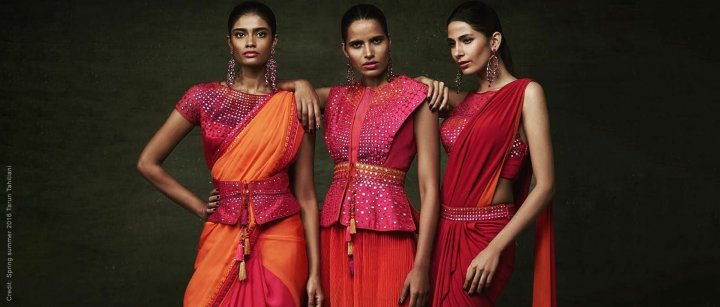
The saree length is a factor which has been highly affected by the modernisation of the saree. Now you can not only find stitched sarees but saree gowns too. In the earlier days, saree length used to vary from 9-11 metres but it has narrowed down to 5-6 metres in the recent times. It is because the long sarees are very difficult to handle and with time, the length of the saree has become more comfortable and easy to handle.
What is the Standard Saree and Pallu Length?
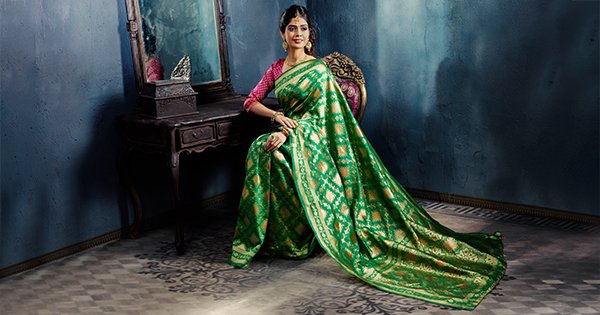
To be true, there is no typical standard saree length. Typically, the length of a saree ranges from 5-9 metres in length and 1.2-1.5 metres in width. The pallu is about 40% of the complete length. For example, if the length of a saree is 5.5 metres then 2.5 metres will be spared for the pallu while 3 meters is for the rest of the saree.
Various Types of Sarees and Their Lengths

Regular Sarees - 5.5 metres

Regular sarees are the ones having a typical length of 5.5 metres. In fact, most casual and regular sarees available online are 5.5 metres long. These are the ones which are worn on a daily basis or on low key occasions.
Sarees that are 5.5 metres long are seen to have the length which is easy to handle. This length provides just the right amount of pleats at the bottom (7-8 pleats) and leaves enough pallu to keep on the shoulder too. Some of the most common fabrics used in such sarees are cotton, georgette, chiffon, etc.
Check out this Shangrila Designer Heavy Zari Kota Silk Saree available on Amazon for Rs.1,039.
Tant Sarees - 6 metres
Tant sarees are known as the traditional Bengali sarees and typically originates from Dhaka, Bangladesh. These are prepared by handloom method of weaving cotton threads together with the utmost care and precision. These sarees are usually little longer than usual and have a length of 6 metres.
They are recognized by thick border and floral, paisley motifs, especially on the pallu. The typical designs are Rajmahal, Bhomra, Ardha-Chandra, Tabji, etc. They are recommended for daily usage but because of the handloom technique, they are a bit expensive. You need to be really careful while wearing Tant sarees as they are very fragile.
A beautiful sample of this type of saree is this yellow saree with zari work all over its body and pallu, available for Rs.2,350 on adimohinimohankanjilal.com.
Kanjeevaram Sarees - 6-9 metres
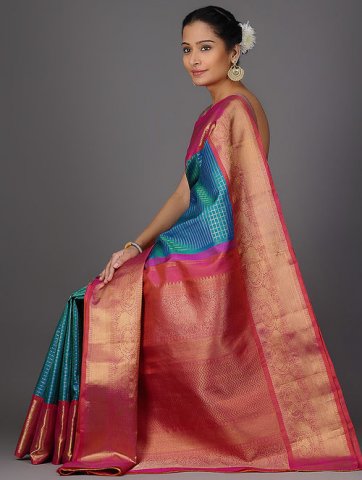
In the earlier times, Kanjeevaram sarees used to be about 11 metres long. However, over a period of time, they became 8-metre sarees and their length usually ranges from 6-9 metres.
The silk which is used to create these sarees is of very fine quality and thus, very expensive too. The highlight of these sarees is their bold colours and very beautiful designs all over. Kanjeevaram sarees with zari work on them are the most popular and can be found in the wedding trousseau of almost all the South Indian brides.
This dazzling saree in blue and red combo from jaypore.com features small checks on the body and intricate zari work in the border. It comes at a price tag of Rs.46,500.
Sambalpuri Sarees - 6 metres or more
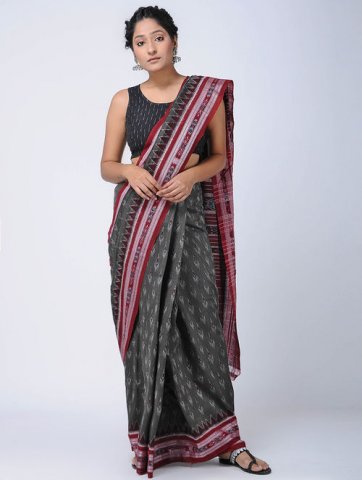
A Sambalpuri saree is usually having more than 6 metres long. However, modernisation has reduced its length to 6 metres too. It is a traditionally handwoven saree manufactured in Odisha which is tie-dyed before weaving.
These sarees are popular for their motifs like Phula, Shankha and Chakra which are all related to the culture and traditions of India. Everything about this saree is very unique and it requires great efforts to put it together. The entire process of dying the weaves and then weaving them together to make a saree takes many weeks and hence these sarees are expensive.
Buy this Grey-Red Sambalpuri Ikat Cotton Saree from jaypore.com which comes at a reasonable price of Rs.5,990.
Nauvari / Kasta Sarees - 9 metres

Also known as Kasta/Kaashtha Saree, Nauvari is a very popular saree in Maharashtra. The highlight of this saree is its length, which is 9 metres. It is worn in a unique dhoti style giving full liberty for the women to walk around.
Nauvari sarees are seen as the symbol of freedom and power as women have fought in wars wearing this saree. Interestingly, this is probably the only type of saree which is worn without a petticoat. As time has changed, the length, as well as the look of the saree changed but you can still find many elderly Maharashtrian women wearing Nauvari sarees.
Limeroad offers this Nauvari saree in classical design made of art silk, available for Rs.2,385.
Bandhani Sarees - 6-6.5 metres
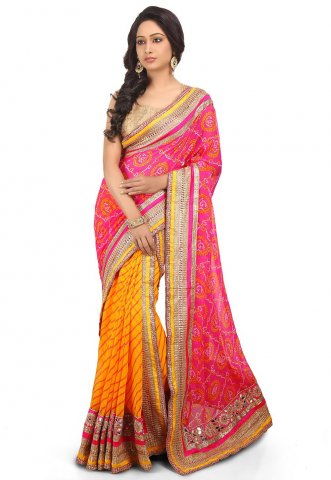
The saree length of Bandhani or Bandhej sarees is known to vary from 6 to 6.5 metres. The term Bandhani means to tie and this saree also depicts the same process as it is tie-dyed in a unique manner to come up with exquisite and unique patterns on it.
It is quite popular in Rajasthan, Gujarat and Punjab region. In fact, the origin of these sarees date back to 4000 B.C. and hence these sarees also belong to the cultural heritage of the country. You can find variations in the designs, namely - Mothra, Ekdali and Shikari. The beautiful Bandhani saree is still worn on a daily basis in some parts of Rajasthan.
A saree with classical bandhani design is this half and half georgette saree in pink and yellow for Rs.6,094, available on utsavfashion.in.
Traditional Kerala Kasuvu Saree - 5 - 7 metres
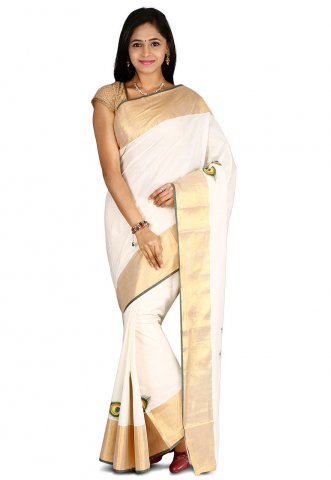
As the name says it all, Kerala Kasuvu sarees are popular in Kerala and are 5-7 metres long. Owing to the recent trends, you will mostly find them in the length of 5.5 metres. Kasuvu is usually a cream coloured saree which is handwoven and has a golden border.
These are mostly worn by Malayali women and they are known as one of the finest quality handwoven sarees in Kerala. Known as the most auspicious attire, these are worn on almost all the occasions and festivals out there. They are also known by the name Mundum Neryathum.
Take a look at this simple yet elegant saree from utsavfashion.in. Priced at Rs.5,544, this cotton kasavu saree has peacock motifs and woven zari border.
Ikat Saree - 6 metres
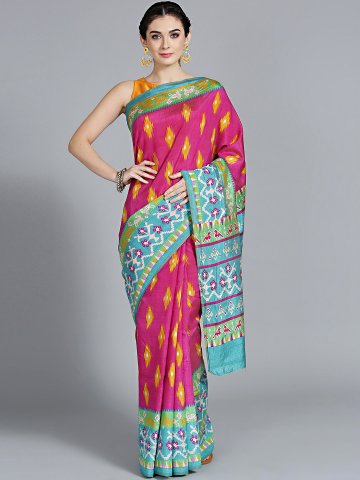
Ikat is actually a dyeing technique in which the yarn is dyed to make desired patterns and the sarees made through this technique are known as Ikat sarees. They are usually 6 metres long and they are manufactured in various parts of the world like Japan, Africa, Latin America, India, etc.
There are various types of Ikat available in the market like Double Ikat, Weft Ikat, Warp Ikat and Pasapalli Ikat, etc. It requires absolute accuracy to dye the yarns so that the right pattern can be achieved through them. In India, you can find the finest quality Ikat Sarees in Odisha. This saree from Myntra is a great Ikat saree that comes at a price of Rs.3,324. It features a vibrant design of red, black and white checks and can be worn for several occasions.
Kalamkari Sarees - 6.3 - 6.5 metres

Kalamkari is known as the art of hand-painting done on silk or cotton sarees and the sarees which are prepared with this method are known as Kalamkari sarees. Because of the beautiful patterns drawn and very unique presentation, their length is kept longer than usual which is about 6.5 metres.
Usually, they are prepared with the hand-painted and block-painted method and are produced in Telangana and Andhra Pradesh. It requires 23 steps to prepare these sarees and only natural dyes are used for it and hence you are going to find their prices a tad higher than other sarees. Make sure to check properly before buying a Kalamkari saree.
This stunning saree available on jaypore.com for Rs.17,550, showcases the beauty of this handcraft technique.
Paithani Saree - 11.5 metres
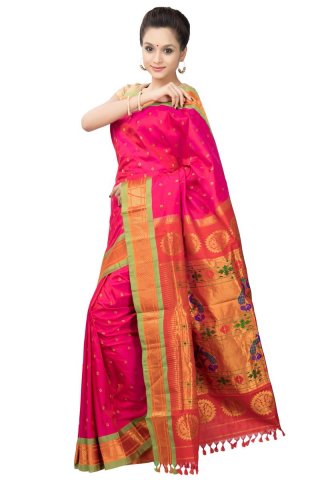
Paithani or Patten is the type which is popular for having a saree length larger than life. A typical and traditional Paithani saree can have a length of 11.5 metres. It is a traditional gold and silk saree which is prepared by using Paithani weaving.
The technique started with cotton sarees and moved towards silk to give it a more elegant and rich look. You can also find exquisite zari work on these sarees. They are definitely quite expensive and perfect for ceremonies and festivals. Because of their whopping length of 11.5 metres, it can be quite tricky to handle them at times. Take a look at this gorgeous pink paithani saree with small butti available on onlypaithani.com for Rs.16,500.
Muga Silk Sarees - 5-5.5 metres

Muga Silk is one of the finest quality silk produced by silkworm in the state of Assam. The sarees prepared by Muga Silk are usually 5 or 5.5 metres long which is a standard length for saree. It is because Muga silk is very expensive and hence the length of the saree is kept short.
This silk is known for its glossiness and durability along with fine texture. With the method of dyeing, it is complemented even more and hence buying a Muga Silk saree can be as expensive as buying gold sometimes. It is usually worn on weddings and very special occasions only. Check out this classical piece on Amazon which comes at a price of Rs.47,590.
Baluchari Saree - 5 metres
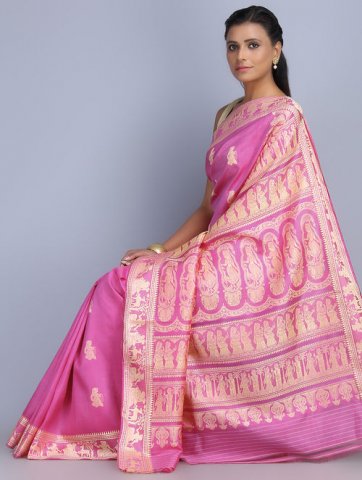
Having lesser than the standard saree length of 5 metres only, Baluchari saree is a popular garment in Bengal and Bangladesh. These sarees are popular for depicting mythological scenarios on their pallu and the only authentic places to find these sarees in India are parts of Murshidabad in West Bengal.
They find their origin about 200 years ago in the village of Baluchar in Murshidabad and hence their name. It takes about a week to prepare one such saree. See the full beauty of this weave in the pink threadwork saree from jaypore.com which can be bought at Rs.13,450.
Various Saree Draping Styles for Any Saree Length

You should know that as the saree length varies from region to region, the draping style also varies according to different regions too. So, we have handpicked a few unique draping styles which are popular all across India and interestingly, with these draping styles, the length of the saree changes too.
Nivi Draping
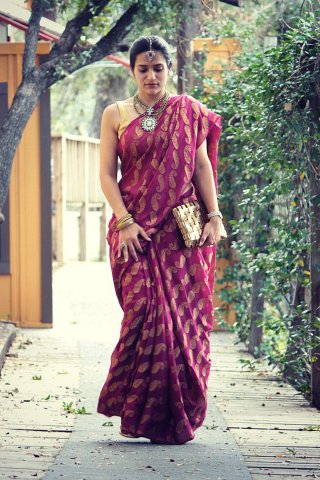
The Nivi draping is the most common type of draping and you can see every other woman wearing a saree in Nivi drapes on a regular basis. The length of these sarees is usually 5.5 metres. The Nivi drapes are the one in which the pleats fall on the front while the pallu is kept on the shoulder in either drapes or free fall. It is the most comfortable form of draping in India.
Mekhela Chador Draping
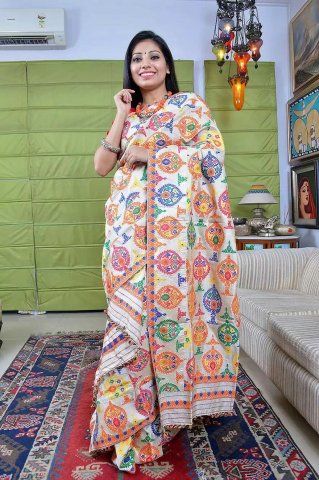
Mekhela Chador is a beautiful way of draping which is very popular in Assam. Usually, all the Assam handloom sarees are draped in this manner and they are worn by the petite women of Assam on a day-to-day basis. The saree is clearly divided into two patterns/parts, the lower drape one and the upper pallu one.
While the lower one is worn in form of pleats which are kept at the front, the upper garment is tucked at the left side of the waist and the other part is worn on the shoulder like a shawl. This draping looks really graceful and elegant.
Nauvari Draping
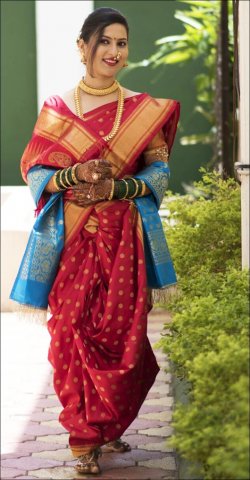
You can see the Maharashtrian women wearing Nauvari on a daily basis. It is a saree having a length of 9 metres. This saree is worn around the legs in dhoti style and hence it is very comfortable to move around in this saree. The upper part goes over the shoulder in the normal manner. Nauvari represents the fierceness and independent women of Maharashtra really well.
Seedha Pallu Draping
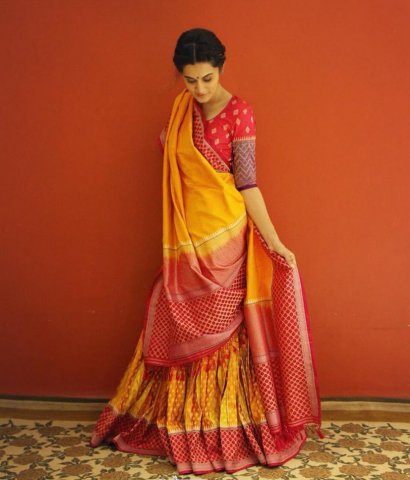
Seedha pallu is a popular draping style in Rajasthan and Gujarat. It resembles heavily to that of a lehenga choli and the pallu of the saree is draped like a dupatta which comes at the front instead of the back side. The pleats are worn in the usual manner at the lower side. This is one of the most classic ways of draping a saree.
Lehenga Style Draping
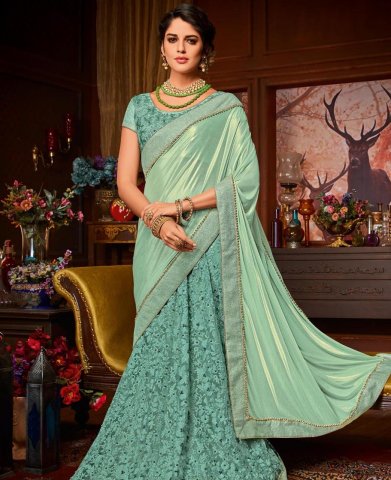
The saree length of those sarees which are worn as lehenga is usually more than usual. It is because, there are no lower pleats, and instead the saree is worn like a lehenga, making small pleats around the waistline to give it a nice flare. The upper pleats are kept on the left shoulder which comes on the front side like a seedha pallu.
-
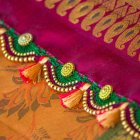 What is Saree Kuchu and How to Find the Perfect Saree Kuchu. 10 Must-Have Designs and Why You Should Use Them (2020)
What is Saree Kuchu and How to Find the Perfect Saree Kuchu. 10 Must-Have Designs and Why You Should Use Them (2020)
-
 7 Latest Saree Kuchu Designs to Give Your Saree a Whole New Look! Also Learn How to Make Your Own Kuchu at Home (2019)
7 Latest Saree Kuchu Designs to Give Your Saree a Whole New Look! Also Learn How to Make Your Own Kuchu at Home (2019)
-
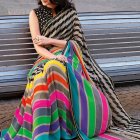 The Best of Myntra's Saree Collection: Step Out Looking Eye Catching in the 10 Hottest Accessories and Sarees Available in Myntra
The Best of Myntra's Saree Collection: Step Out Looking Eye Catching in the 10 Hottest Accessories and Sarees Available in Myntra
-
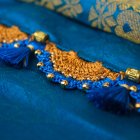 Add a Dazzling Edge to Your Six Yards with the Most Beautiful Saree Laces. Also Learn How to Stitch Lace Onto Your Saree at Home (2019)
Add a Dazzling Edge to Your Six Yards with the Most Beautiful Saree Laces. Also Learn How to Stitch Lace Onto Your Saree at Home (2019)
-
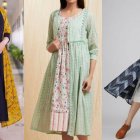 Pair Kurtis with Shrugs For A Dramatic Style Statement: Here Are 10 Curated Ensembles To Check Out(2020)
Pair Kurtis with Shrugs For A Dramatic Style Statement: Here Are 10 Curated Ensembles To Check Out(2020)
Your Drape, Your Style
Sarees are the best drape for any woman as it is one of the most feminine attires across the globe. Though it is a bit difficult to drape and handle, it still brings out a certain elegance that no other piece of cloth can. Make sure you find the right length of saree and drape it well before you step out so that you are comfortable in your saree. In the end, it is your drape and your style.

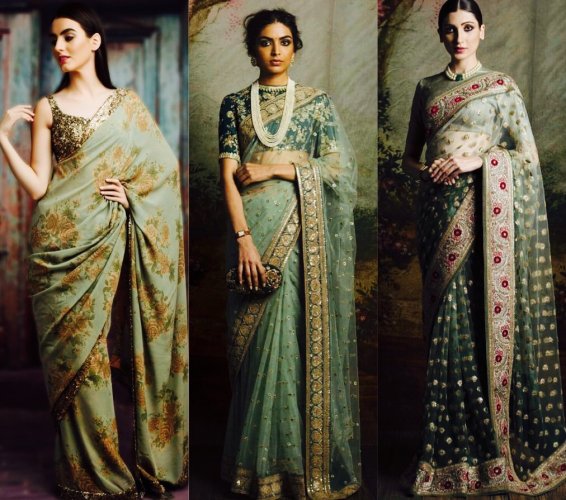

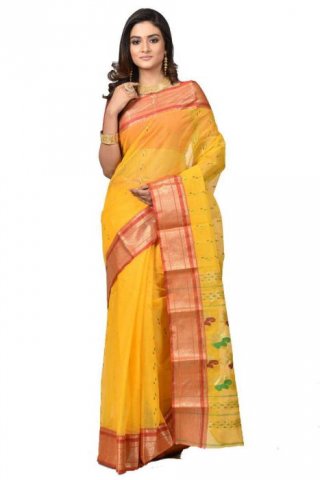
 Highlight the Best Facets of Your Incomparable Beauty: Discover the Best Face Highlighter Currently Available in India and Everything You Need to Know About Using Face Highlighters for Maximum Effect (2023)
Highlight the Best Facets of Your Incomparable Beauty: Discover the Best Face Highlighter Currently Available in India and Everything You Need to Know About Using Face Highlighters for Maximum Effect (2023)
 Forget the Blemishes and Get that Picture Perfect Flawless Radiance on Your Face: Check out the Best Foundations for Oily Skin Currently Available in India and Everything You Need to Know About Makeup Foundations (2023)
Forget the Blemishes and Get that Picture Perfect Flawless Radiance on Your Face: Check out the Best Foundations for Oily Skin Currently Available in India and Everything You Need to Know About Makeup Foundations (2023)
 Make Your Presence Felt Wherever You Go: Discover the Best Perfumes Under 2000 for Both Men and Women to Announce Your Arrival and Make Any Occasion Memorable (2023)
Make Your Presence Felt Wherever You Go: Discover the Best Perfumes Under 2000 for Both Men and Women to Announce Your Arrival and Make Any Occasion Memorable (2023)
 Protect Your Oily Skin from the Harmful Rays of the Sun: Discover the Best Gel Based Sunscreens for Oily Skin and Everything You Need to Know Before Buying One (2023)
Protect Your Oily Skin from the Harmful Rays of the Sun: Discover the Best Gel Based Sunscreens for Oily Skin and Everything You Need to Know Before Buying One (2023)
 Minor Blemishes and Wrinkles Affecting Your Confidence? Check out the Best BB Creams to Conceal Your Worries and Nourish Your Skin to Restore the Healthy, Radiant and Glowing Complexion Back Again (2023)
Minor Blemishes and Wrinkles Affecting Your Confidence? Check out the Best BB Creams to Conceal Your Worries and Nourish Your Skin to Restore the Healthy, Radiant and Glowing Complexion Back Again (2023)
